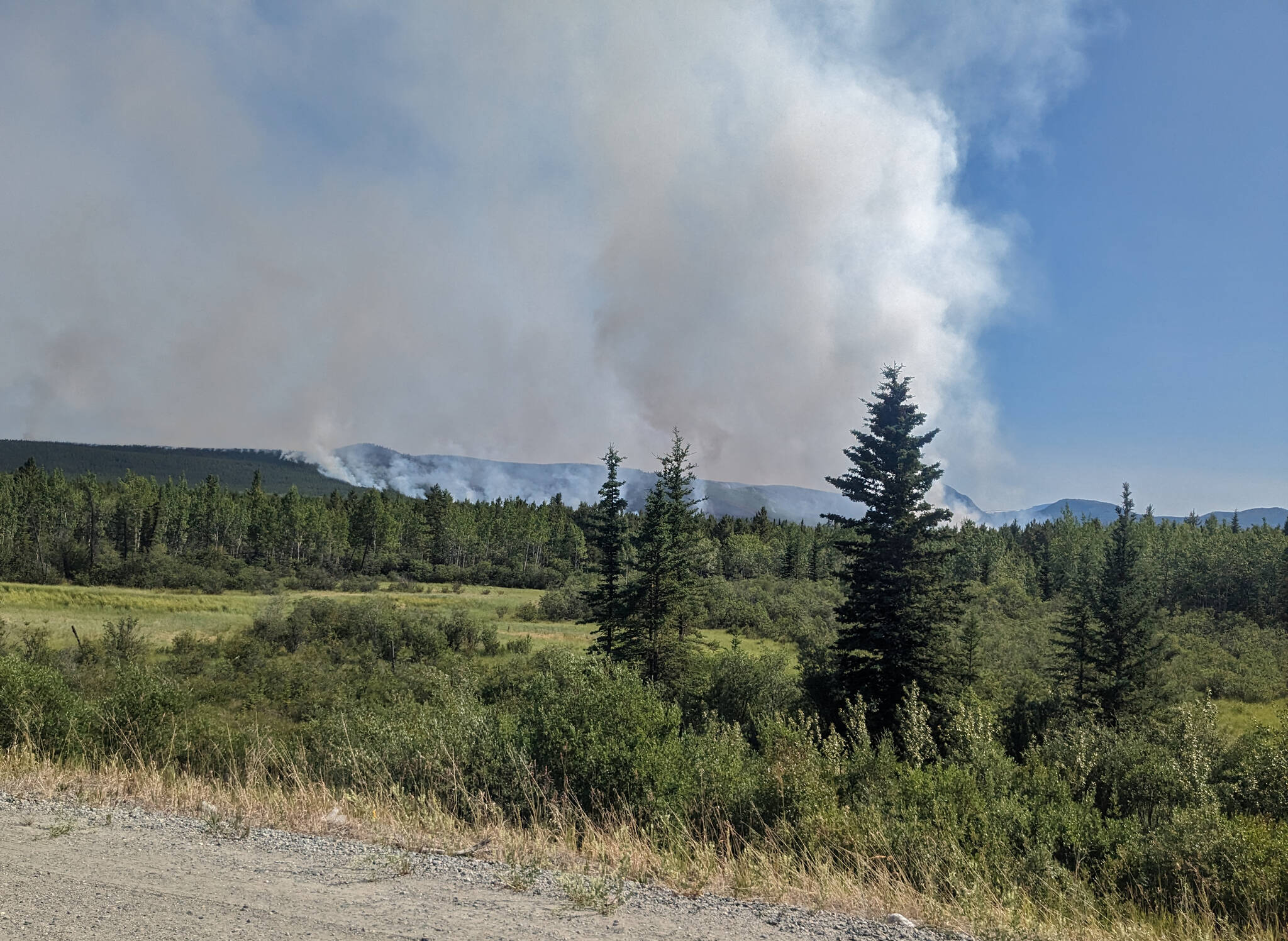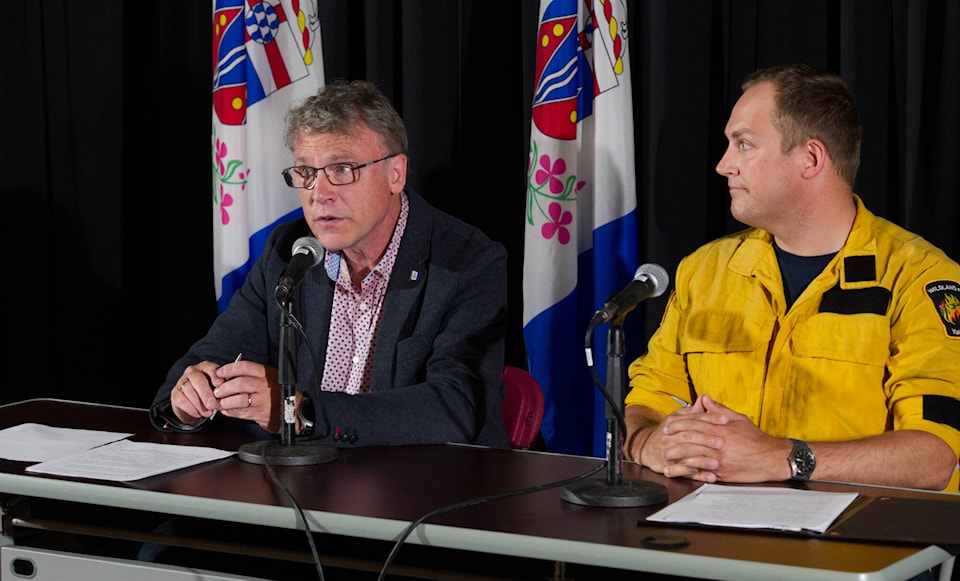Days after its discovery, the wildfire in Ibex Valley, west of Whitehorse, is still burning out of control.
Although the blaze had grown to 1,398 hectares in size as of July 12, Yukon Wildland Fire Management officials say the guards set up to keep it away from the Alaska Highway and homes in the area have held.
The guards were put in place using heavy equipment overnight immediately after the fire was discovered on July 9, and small controlled burns lit with hand torches have been deployed to reinforce them. Aerial ignitions are being considered if conditions allow.
According to Wildland Fire, work earlier in the week was focused on securing the northeast side of the fire nearest to the highway. As of early in the day on July 11, other areas were too smoky to be safely accessed.
Along with the bulletins going out to the media and public since the Ibex Valley fire was discovered, officials from the territorial government and Wildland Fire offered a more thorough picture of the fire situation on July 11. Community Services Minister Richard Mostyn and fire information officer Mike Fancie spoke to reporters, explaining the fire’s growth to that point and the efforts to keep it away from homes and the highway.
“The intense wildfire season our neighbors in the South have experienced this summer has finally arrived in the territory. And while we know seeing plumes of smoke nearby can be stressful, we are urging all Yukoners to keep themselves informed and to stay calm,” Mostyn said.
The minister stressed the importance of responsible use of firearms, ATVs and other items that could lead to a fire. He also urged Yukoners to have a 72-hour emergency kit with essentials such as food, water and medications stockpiled in their homes.
Although the fire has grown rapidly, from approximately 300 hectares shortly after its discovery to 782 hectares on the evening of July 10, to the current estimate of more than 1,300 hectares, Fancie said the fire guard is doing its job. An additional guard along the base of Ibex Ridge is also planned. Fancie said weather conditions have caused the fire to spread to the south, away from the highway, and noted that the smoke is creating favourable cooler and more humid conditions.

Homes remain on evacuation alert as a result of the fire. This means residents must be prepared to evacuate on short notice but don’t have to go yet. The alert area extends from kilometre 1,472 to kilometre 1,440 of the Alaska Highway, roughly from the bridge where the highway crosses the Takhini River to Echo Valley Road and covering all properties both north and south of the highway. Fancie said 155 homes are affected by this alert.
Fancie said the cause of the fire remains unknown but investigators from the fire marshal’s office are working to figure it out.
The Ibex Valley fire is not the only one that will have impacts for Yukoners.
The Reverse Creek fire, currently burning 3,690 hectares in size, is located north of Stewart Crossing. Fancie said the fire is burning unevenly because there is not continuous forest in the area.
An evacuation alert for this fire covers homes from kilometre 10 to kilometre 35 of the Silver Trail.
Fancie urged those under evacuation alert from any fire to designate a safe meeting place to link up with their families should they have to leave their homes, to gather essential items in to “grab and go” bags, to make arrangements for pets or livestock and to ensure the gas tanks on their vehicles are full. Those who may need assistance evacuating can register with emergency services by calling 867-332-4597. Potential evacuees are asked to make arrangements for temporary accommodations but Fancie said emergency housing would be provided if necessary.
Fancie said the Illusion Creek fire, burning on 8,700 hectares south of Little Salmon Lake, is leading to reports of haze and smoke on the Robert Campbell Highway and in Faro.
South of the border with British Columbia, there is now a fire burning in the vicinity of the Stewart-Cassiar Highway. Information from the B.C. Wildfire Service shows the Little Blue River fire burning out of control over an area of about 30,000 hectares. Earlier in the week motorists were being advised to avoid the route but it is now open with some sections having a closed lane and a pilot car escort.
Fancie said the territory’s emergency measures organization is exploring contingencies should fires affect either the Alaska Highway or other main transportation routes.
As the number and size of fires burning in the territory increase, the Yukon has recalled its firefighters who had been deployed outside the territory and Fancie said conversations have taken place about bringing in resources from Outside. A benefit of the out-of-territory deployments of Yukon firefighting resources are crews that Fancie said are “very seasoned.” He stressed that fatigue management is always top of mind as the long days on the fire line add up.
Fancie said there are 32 firefighters working in the Ibex Valley alone. Helicopters and air tankers have been in use throughout action against the fire. Added to that contingent late in the day on July 10 was a AS-332 Super Puma, which Fancie said is the only heavy-lift helicopter in the territory.
One countermeasure to ensure firefighting resources don’t become stretched thin that was discussed at the July 11 briefing was the “level 2” campfire ban that went into effect over the weekend. This restriction means that fires are allowed only in the fire pits and stoves at road accessible campgrounds. Fancie said this restriction was brought in as a response to the Ibex Valley fire. He added that a full ban on fires is not yet in place because the good fire pits at the campgrounds make a runaway blaze unlikely and because fire crews could quickly get a hold of it if they can easily access the area by road.
As of the most recent special air quality statement issued by Environment Canada, Whitehorse itself is not experiencing poor air quality due to wildfire smoke, however the Ibex Valley and areas north of it are being seriously impacted. Those in the affected areas are being urged to reduce their exposure to the smoke when possible. The air quality statement notes that it can be especially harmful to people with lung disease or heart disease, older people, children, pregnant people and those who work outside.
Although fires are burning close to Yukon communities, Mostyn said information gathered by the territory’s emergency command centre suggests that most of the smoke is drifting up from fires to the south.
Contact Jim Elliot at jim.elliot@yukon-news.com
